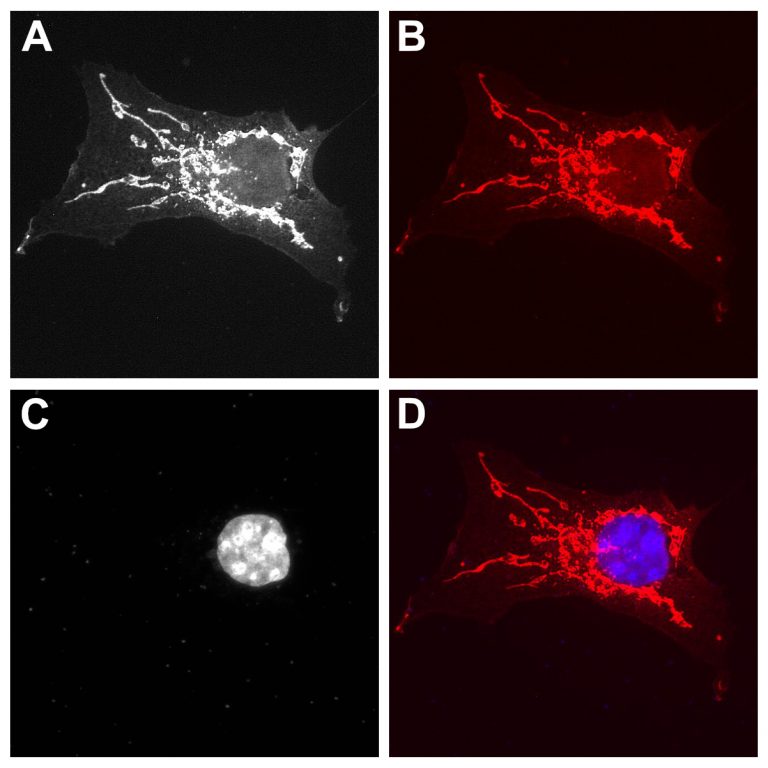FluoTag®-X4 anti-RFP
400,00 €
FluoTag®-X4 anti-RFP is a blend of two in-house developed single-domain antibodies (sdAbs) recognizing the most common red fluorescent proteins like mRFP, mCherry, DsRed, and other DsRed derivatives with high affinity and specificity.
One of the first red-emitting fluorescent proteins described was DsRed from Discosoma sp. After a couple of years from its publication in 1999 and more than 20 mutations, a monomeric version with several enhanced characteristics appeared as mRFP1. From this promising monomeric red-FP, dozens of monomeric variants have been described, being mCherry one of the most popular derivatives. Today more than 800 entries of various fluorescent proteins can be found in an open-source database with the most currently available variants in the fluorescence protein database “fpbase”
Our nanobodies bind specifically and strongly to DsRed, RFP, and mCherry, among other family members. Look at our specificity chart in the resource section.
FluoTags are directly conjugated to fluorophores, however, they can be equipped with a single fluorophore for more quantitative readouts (FluoTag-Q), with two fluorophores per single-domain antibody (FluoTag-X2), and we also developed a blend of two sdAbs bindings simultaneously the target proteins and each bearing two fluorophores, decorating the target protein with 4 fluorophores in total (FluoTag-X4). For more detailed information on the FluoTags, please check our Technology Section.
| Variations: |
|
||||||||||||||||||||||||
|---|---|---|---|---|---|---|---|---|---|---|---|---|---|---|---|---|---|---|---|---|---|---|---|---|---|
| Related Products: | - | ||||||||||||||||||||||||
| Clone: | 2B12, 2A1 | ||||||||||||||||||||||||
| Host: | Alpaca | ||||||||||||||||||||||||
| Produced in: | E.coli | ||||||||||||||||||||||||
| Application: | IF | ||||||||||||||||||||||||
| Dilution: | 1:250 (corresponding to 5 nM for each sdAb clone) | ||||||||||||||||||||||||
| Capacity: | N/A | ||||||||||||||||||||||||
| Antigen: | - | ||||||||||||||||||||||||
| Targets: | mRFP | ||||||||||||||||||||||||
| Specificity: | mRFP (red fluorescent protein) and other derivatives like mOrange, dsRed1, dsRED2, tdTomato, mCherry and mScarlet-i. | ||||||||||||||||||||||||
| Formulation: |
A mixture of two sdAb clones lyophilized from PBS pH 7.4 containing 2% BSA (US-Origin). Reconstitute with 200 µL of 50 % glycerol in deionized water. We recommend including 0.1 % sodium azide as a preservative if applicable. When reconstituted in 200 µl, the concentration of each individual single-domain antibody is 1.25 µM |
||||||||||||||||||||||||
| kDa: | - | ||||||||||||||||||||||||
| Ext Coef: | - | ||||||||||||||||||||||||
| Shipping: | Ambient temperature | ||||||||||||||||||||||||
| Storing: |
Vials containing lyophilized protein can be stored at 4 °C for 6 months. We recommend reconstituting the protein with 50 % sterile glycerol including 0.1 % sodium azide as preservative if applicable. Minimize the number of freeze-thaw cycles by aliquoting the reconstituted protein. Long term storage at -80 °C for up to 6 months. Working aliquots can be stored at -20 °C for up to 4 weeks. We do not recommend storing the reconstituted protein at 4 °C. |
||||||||||||||||||||||||
| Protocols: |
This Product is not recommended to be used to detect proteins in Western Blott, sdAbs tend to recognize mainly native/folded proteins. Look at detailed protocols and our specificity chart in our Resource Section.
|
||||||||||||||||||||||||
| References: |
|
||||||||||||||||||||||||
| Notice: | To be used in vitro/ for research only. Non-toxic, non-hazardous, non-infectious. | ||||||||||||||||||||||||
| Legal terms: | By purchasing this product you agree to our general terms and conditions. |
















